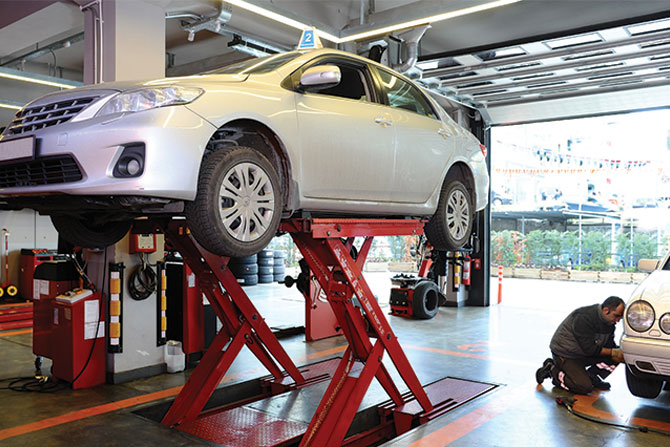By The Montana Auto Dealers Association
If you live in the U.S., you already know what most people want for their children: a university education followed by a high-paying white-collar job. The decision to earn a four-year academic degree has also traditionally been encouraged by the high school that the students attend, as most are focused on academics and getting students ready for college.
Unfortunately, adults generally don’t prepare good students for anything other than college.
That is an unfortunate mistake, because the career path of a four-year degree is not for everyone. This is something that teachers have long known. In 20/20 hindsight, so do parents and students themselves. But economists are now weighing in as well because millions of good-paying jobs are opening up in the trades. And some pay better than what the average college graduate makes.
The reality is that it is possible for just about anyone to get a particular skill in a particular field and make more than a college graduate. According to www.salary.com, the salary range for an automotive mechanic is between $34,102 and $44,764, and while that may seem less than the salary for a fair number of jobs that require a college degree, starting salary also doesn’t take into account what’s possible once someone gains experience and credentials. According to NADA, a master technician can earn $69,703. A service advisor can earn $62,333. Down the road, in as little as five years, a six-figure salary is completely achievable.
So why has the PR for trade careers not been as glowing as that of college graduates?
Part of the problem is that “averages lie.” Also, according to Anthony Carnevale, the director of the Georgetown University Center on Education and the Workforce, the averages often quoted with salaries of those in skilled trades, when compared with college graduates, tend to lump people who work at RadioShack or Target in with master carpenters and electricians. That skews the numbers.
Sometimes, of course, getting a college degree makes sense. But it isn’t the automatic right choice that so many people think it is. According to Carnevale, “The baby-boom workers are retiring and leaving lots of openings for millennials, many of which are in the trades.”
Student debt is widely referenced as this generation’s top financial concern. Tuition costs, especially during the last decade, have increased to the point where most students have a hard time paying off the loans they had to take out if they wanted to get a university degree.
Pushing students in the direction of something they aren’t 100% committed to, don’t want or can’t afford is not just short-sighted; it is wasteful. A better alternative is to encourage students to use the last couple of years of high school as a time to explore the skilled trades. Using the time this way increases the options students have after graduation. No one is hurt by learning how to work at something that is purely practical. If they want to return to a university later in life, they can. In addition, many workers later in life start their own businesses within the field, using their knowledge and experience to create more jobs for others. In the meantime, they have real-world skills that can make going back to school much easier when and if that becomes something they want for themselves.
When weighing a career in the trades as opposed to four-year college career path, too many people have overlooked the obvious: trade school costs less, takes less time and can be the foundation for a good, well-paid career. Those who take up a trade can work for someone else or start a company. It’s a stable career path.

Consider the automotive industry. It does not currently have anywhere near enough people to fill its empty technician jobs. Charlie Gilchrist, a dealer and the former NADA chairman, gave a keynote speech in January 2019 at the NADA show in which he said his industry is experiencing what he called “a dangerous shortage of technicians.” Why is the shortage dangerous? Technicians are either retiring or quitting faster than they can be replaced, and training programs sponsored by automakers have empty seats in them. The demand for entry-level auto technicians has gotten worse instead of better, according to Greg Settle, the national initiatives director for TechForce Foundation. Significantly, the U.S. Bureau of Labor Statistics estimates the industry will need approximately 46,000 more auto techs by 2026.
Why aren’t more people interested in an automotive career? Some of the shortage has undoubtedly been caused by the social pressure to go to college instead, even though that pressure results in truly staggering amounts of toxic debt and a delayed entry into the workforce. But that doesn’t account for all of it. Dealerships themselves could do a great deal to make their companies more attractive.
Adam Robinson, CEO of a company named Hireology, which is located in Chicago, lists three key factors that have caused the tech shortage: an unclear career path, variable pay plans, and working hours that are not great. Technicians also often spend a large amount of money ($5,000 to $50,000) on their own tools.
Any dealership that addresses these problems upfront will have a competitive advantage. That is something to keep in mind, considering the fact that each technician in a shop creates $1,000 per work day in gross revenue. An Automotive News survey, conducted in 2016, found that dealers think they could increase revenue in fixed ops by 17 percent if they had as many techs as they wanted.
In other words, young people who are interested in becoming mechanics in the automotive industry right now have a very bright future.
Consider this:
- Americans owe more than $1.4 trillion in student loan debt
- The average student loan is $38,000
- The average repayment time is 21 years
- Forty percent of students in four-year college programs drop out
- One in 4 college graduates are unemployed or underemployed










